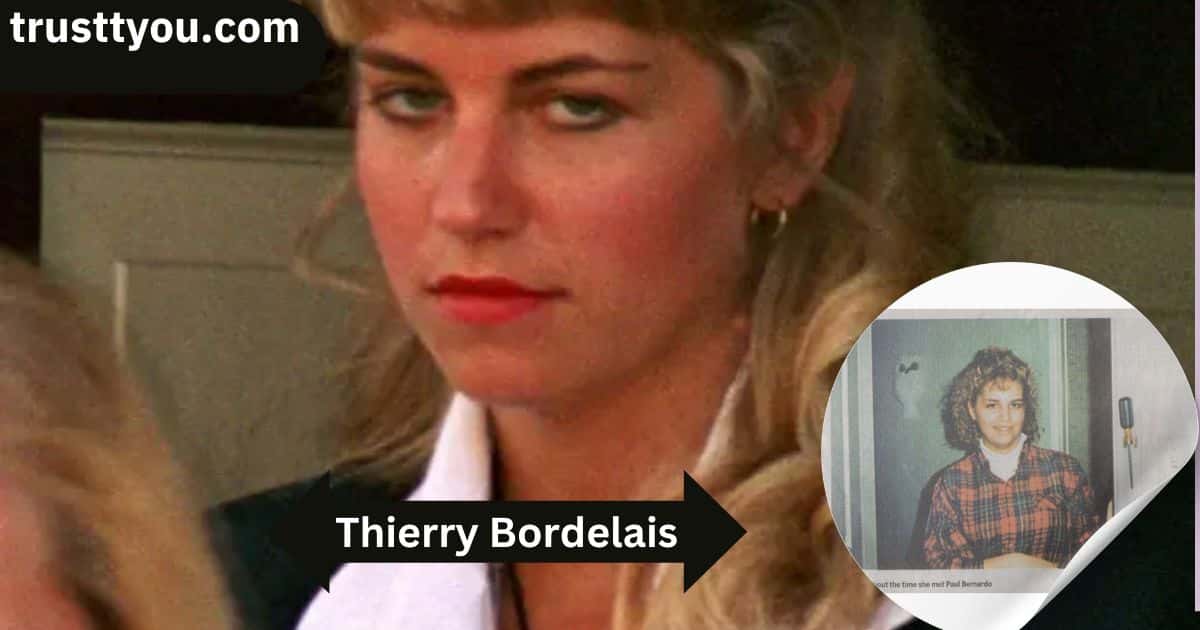In the complex tapestry of human relationships, few stories have captivated and polarized public opinion quite like the marriage of Thierry Bordelais and Karla Homolka. This in depth profile aims to shed light on the man who chose to build a life with one of Canada’s most infamous criminals, exploring the nuances of their controversial union and the ripple effects it has had on their lives and the broader societal context.
Early Life and Background
Thierry Bordelais’ early life remains shrouded in relative obscurity, a stark contrast to the intense media scrutiny that would later define his public persona. Born and raised in Quebec, Bordelais grew up in a middle class family in the Montreal suburb of Chateauguay. His upbringing, by all accounts, was unremarkable a fact that would later puzzle many when considering his extraordinary life choices.
CLICK HERE .if you need more informative thingshe roots of Bordelais character were planted in the quiet streets of Chateauguay, far from the storm of controversy that would later engulf his life. Local historian
Bordelais pursued his education with diligence, eventually earning a degree in law. This choice of career would prove fateful, setting the stage for his future encounter with Karla Homolka. His early professional life was marked by a commitment to justice and a belief in the rehabilitative potential of the legal system ideals that would be put to the ultimate test in his personal life.

The Fateful Meeting
The paths of Thierry Bordelais and Karla Homolka crossed in a way that seems almost scripted for a true crime drama. Homolka, fresh from her release from prison in 2005 after serving a 12-year sentence for her role in the murders of Leslie Mahaffy and Kristen French, was navigating the treacherous waters of reintegration into society. Bordelais, at the time, was working as a lawyer, though not directly involved in Homolka’s case.
Their initial encounter, shrouded in controversy, raised eyebrows and sparked heated debates about the nature of redemption and the limits of forgiveness. Bordelais, aware of Homolka’s criminal past, made the conscious decision to pursue a relationship with her a choice that would define the rest of his life.
Timeline of Karla Homolka’s Release and Subsequent Events
| Date | Event |
|---|---|
| July 4, 2005 | Karla Homolka released from prison |
| 2005-2007 | Homolka meets Thierry Bordelais |
| February 2007 | Homolka and Bordelais marry |
| 2007-Present | The couple has three children |
The Decision to Marry
Thierry Bordelais‘ decision to marry Karla Homolka in 2007 sent shockwaves through Canadian society and beyond. The union of a respected lawyer with a convicted killer challenged societal norms and raised profound questions about love, forgiveness, and the possibility of rehabilitation.
Bordelais in rare public statements, has maintained that his decision was based on a belief in Homolka’s capacity for change and a deep personal connection. However, this stance has been met with skepticism and outright condemnation from many quarters.
CLICK HERE .if you need more informative thingsPublic Reaction to the Marriage
- Outrage: Many felt the marriage was an affront to the victims’ families
- Disbelief: Questions arose about Bordelais’ judgment and mental state
- Curiosity: Some were intrigued by the psychological dynamics at play
- Support: A minority viewed the union as a testament to the power of redemption
The media frenzy surrounding their marriage was intense, with reporters camped outside their home and tabloids speculating wildly about their relationship. This scrutiny would become a constant in their lives, shaping their decisions and interactions with the outside world.
Life After the Wedding
In the years following their controversial wedding, Thierry Bordelais and Karla Homolka have attempted to carve out a semblance of normalcy amidst extraordinary circumstances. Their life together has been marked by a constant tension between the desire for privacy and the inescapable public interest in their story.
Settling into married life proved challenging for the couple. They faced numerous obstacles, including:
- Finding employment and housing
- Dealing with constant media attention
- Navigating social relationships
- Addressing legal and bureaucratic hurdles
Bordelais took on the role of Homolka’s primary support system, helping her reintegrate into society while simultaneously shielding her from public hostility. This balancing act required tremendous emotional resilience and strategic thinking on his part.
Fatherhood and Family Life
Perhaps the most controversial aspect of Thierry Bordelais and Karla Homolka’s relationship has been their decision to have children. The couple are parents to three children, a fact that has reignited public debate about Homolka’s fitness as a mother given her criminal past.
Bordelais has been fiercely protective of his family’s privacy, going to great lengths to shield his children from the media spotlight and the dark legacy of their mother’s actions. This has included:
- Relocating multiple times to avoid public scrutiny
- Using aliases in certain situations
- Limiting public appearances and social media presence
- Carefully controlling information about their children’s lives
The children are innocent in all of this. Our primary concern is their well-being and protecting them from the sins of the past. Thierry Bordelais
The challenges of raising a family under such circumstances are immense. Bordelais must constantly navigate the delicate balance between honesty and protection, deciding how and when to address their mother’s past with their children.

Professional Life and Career
Thierry Bordelais‘ professional life has been irrevocably altered by his marriage to Karla Homolka. His career as a lawyer, once promising, has been overshadowed by his personal choices. The impact on his professional relationships and opportunities has been significant:
- Loss of clients: Many were unwilling to be associated with Homolka’s husband
- Limited career advancement: High-profile positions became untenable
- Shift in focus: Bordelais has largely withdrawn from public legal practice
To adapt to these circumstances, Bordelais has reportedly pivoted to more behind-the-scenes legal work, focusing on research and consultation rather than courtroom appearances. This shift allows him to utilize his legal expertise while minimizing public exposure.
Coping with Public Perception
Living under the intense scrutiny of public opinion has been a defining feature of Thierry Bordelais’ life since his marriage to Karla Homolka. The media portrayal of Bordelais has been largely negative, with many outlets questioning his judgment and moral character.
Common Public Perceptions of Thierry Bordelais
- Naive or easily manipulated
- Morally compromised
- Complicit in minimizing Homolka’s crimes
- Victim of Stockholm syndrome
Dealing with this overwhelmingly negative public opinion has required Bordelais to develop thick skin and effective coping strategies. These have included:
- Maintaining a low public profile
- Refusing most interview requests
- Focusing on family and close friendships
- Seeking legal recourse against particularly egregious media coverage
Bordelais and Homolka have worked tirelessly to maintain their privacy, often relocating to avoid media attention. Their efforts to build a quiet life away from the public eye have been largely successful in recent years, though periodic flare-ups of interest continue to disrupt their attempts at normalcy.
CLICK HERE .if you need more informative thingsPsychological Impact
The psychological toll of living with the knowledge of Karla Homolka’s crimes while maintaining a loving relationship with her is difficult to fathom. Thierry Bordelais has had to reconcile his personal feelings for Homolka with the horrific nature of her past actions.
This cognitive dissonance likely requires significant psychological effort to maintain. Experts speculate that Bordelais may employ various coping mechanisms:
- Compartmentalization: Separating Homolka’s past from her present self
- Rationalization: Focusing on her rehabilitation and changed behavior
- Denial: Minimizing the severity or reality of her crimes
- Hyper-vigilance: Constantly monitoring for signs of relapse or danger
The long-term effects of this psychological strain on Bordelais’ mental health are a matter of speculation, as he has not spoken publicly about his emotional state. However, the stress of their situation undoubtedly takes a toll on both individuals and their relationship.
Legal and Ethical Considerations
Thierry Bordelais’ marriage to Karla Homolka has placed him in a unique legal and ethical position. While he has not been implicated in any criminal activity, his association with Homolka has raised questions about his professional ethics as a lawyer and his moral judgment.
Legal Challenges Faced by Bordelais
- Potential disbarment proceedings (though none have been publicly reported)
- Defamation suits against media outlets for damaging coverage
- Privacy protection cases to shield his family from intrusion
The ethical debates surrounding their relationship are complex and ongoing. Critics argue that by marrying Homolka, Bordelais is implicitly condoning her past actions or at least minimizing their severity. Supporters counter that his choice represents a belief in redemption and the power of rehabilitation.
Bordelais has largely remained silent on the plea bargain that saw Homolka serve only 12 years for her role in multiple murders. This silence has been interpreted by some as tacit approval of the deal, while others see it as a necessary step in moving forward with their lives.
Support System and Allies
Despite the overwhelming negativity surrounding their relationship, Thierry Bordelais and Karla Homolka have managed to maintain a small but significant support system. This network has been crucial in helping them navigate the challenges of their unique situation.
Key Components of Their Support System
- Family members: Particularly Bordelais’ sister, Sylvie Bordelais, who has publicly defended the couple
- Close friends: A small circle of trusted individuals who have stood by them
- Legal advisors: Professionals who help manage their legal challenges
- Mental health professionals: Therapists and counselors who provide ongoing support
Building and maintaining this support network has been a delicate process, requiring careful vetting and trust-building. The couple has had to be extremely cautious about who they allow into their inner circle, given the potential for exploitation or betrayal.
The Present Day
As of 2024, Thierry Bordelais and Karla Homolka continue to live their lives largely out of the public eye. While periodic media reports surface about their whereabouts or activities, the couple has become adept at maintaining their privacy.
Current Status (as of 2024)
- Location: Believed to be living in a small town in Quebec
- Family: Three children, all under 18
- Occupation: Bordelais reportedly works in legal consulting, while Homolka’s employment status is unknown
- Public presence: Minimal, with no social media footprint
The couple’s ability to adapt over the years has been remarkable, given the intensity of public interest in their story. They have weathered numerous storms, including:
- Public outrage over Homolka’s release and subsequent marriage
- Media exposés about their living situations
- Legal battles to protect their privacy
- Ongoing debate about the appropriateness of their family life
Despite these challenges, they appear to have carved out a semblance of normalcy, focusing on raising their children and maintaining as low a profile as possible.
CLICK HERE .if you need more informative thingsReflections and Insights
The story of Thierry Bordelais and Karla Homolka offers a unique window into the complexities of human relationships, the nature of forgiveness, and the long-lasting impact of high-profile crimes on all involved.
Key Lessons from Bordelais’ Experience
- The power of personal choice in the face of societal judgment
- The challenges of reconciling love with moral considerations
- The ongoing impact of criminal actions on families and communities
- The difficulty of achieving true privacy in the age of mass media
Bordelais’ decision to build a life with Homolka challenges our notions of redemption and the limits of forgiveness. It raises uncomfortable questions about second chances and the possibility of genuine change in individuals who have committed heinous acts.
The Bordelais-Homolka case forces us to confront our beliefs about justice, rehabilitation, and the capacity for human change. It’s a Rorschach test for our views on crime and punishment. Criminology professor
Conclusion
Thierry Bordelais‘ life trajectory serves as a stark reminder of how a single decision can alter the course of one’s existence. His choice to marry Karla Homolka thrust him into a spotlight he never sought, forcing him to navigate an ethical and emotional minefield few could imagine.
As we reflect on Bordelais’ story, we’re left with more questions than answers. Can love truly conquer all, even a past as dark as Homolka’s? Is it possible for someone who has committed such terrible acts to genuinely change and deserve a second chance at life? And what responsibility do we, as a society, have in allowing for redemption while also honoring the memory of victims?
These are not easy questions to answer, and Thierry Bordelais‘ life stands as a testament to the complexity of human nature and the often blurry lines between right and wrong. As we grapple with these issues, perhaps the most important lesson we can take from his story is the need for empathy and nuance in our judgments, even in the face of actions we find difficult to comprehend.


Jack Morris, the founder of Trustt You, brings you the latest in celebrity news and insights. With contributions from experienced writer Oliver Ollie, Trustt You delivers accurate, engaging content on bios, net worth, and more, keeping you up-to-date on your favorite stars.







